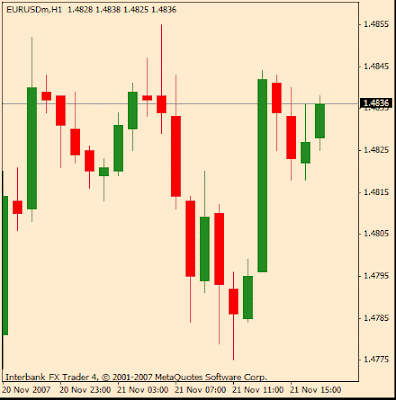Charting
In order to start trading we need charts to assist us in analysing the currency pairs we want to trade. Most brokers or trading platforms have charting available with their dealing stations. Charts can vary from very basic to sophisticated.
You can choose to use your brokers charting or a separate charting package that you might prefer. If you are not sure where to get charts from then download free demo charts here. Remember demo currency prices are normally the same as the live currency prices. Your broker would probably run the demo prices on a separate server to his live prices, they are not generally delayed prices.
Chart Types
There are three main types of charts used in Forex Trading.
- Line Graphs
- Bar Charts
- Candle stick Charts
EURUSD 1 Hour Line Chart

A simple line chart draws a line from one closing price to the next closing price. When strung together with a line, we can see the general price movement of a currency pair over a specific period of time.
2 Bar Charts

A bar chart shows 4 prices on each bar. The opening price, the high price, the low price and the closing price for that specific time period. The bottom of the vertical bar tells us the low and the top of the vertical bar shows the high for that specific time period. The horizontal hash on the left side of the bar is the opening price, and the right-side horizontal hash is the closing price.
EURUSD 1hr Bar Chart
Open Price: The little horizontal line on the left is the opening price
High price: The top of the vertical line defines the highest price of the time period
Low price: The bottom of the vertical line defines the lowest price of the time period
Close price: The little horizontal line on the right is the closing price.
3 Candlestick charts
Candlestick charts show the same information as bar charts, in a colour graphic format.
Candlestick bars show the high-to-low range with a vertical line. On a candlestick bar the larger block in the middle shows the range between the opening and closing prices. (often referred to as the real body) The long sections above and below each candle are the high and low prices for that candle (referred to as the shadow or wick of the candle)
1 Hr Euro USD Candlestick chart
 In this example, the filled colours are red and green. On the Green Bars the bottom of the green area is the opening price and the top of the green area is the closing price. The shadow at the top is the high price and the shadow at the bottom is the low price.
In this example, the filled colours are red and green. On the Green Bars the bottom of the green area is the opening price and the top of the green area is the closing price. The shadow at the top is the high price and the shadow at the bottom is the low price.On the red bars the top of the red area is the opening price and the bottom of the red coloured area is the closing price. The shadows above and below the red candle represent the high price and the low price for the candle.
If the price closed higher than it opened, the candlestick would be green. If the price closed lower than it opened, the candlestick is red.
The information on a bar chart is the same as on a candlestick chart. OHLC (Open, High, Low, Close) Candlestick charting creates a an easy visual aid, making it simpler for us to interpret.
The advantages of candlestick charting are:
- Candlesticks are easy to interpret, specially for beginners
- Candlesticks are easy to use, they create an immediate visual interpretation.
- Candlesticks form patterns that can help identify trading opportunities.
- Candlesticks make it easy to identify turning points or reversals from uptrend’s to downtrend’s or vise versa.
Analysis
There are 2 types of analysis we can use for to trade Forex1. Fundamental analysis
2. Technical analysis.
Some traders base their trading decisions on Fundamental Analysis and others on Technical Analysis.
Fundamental Analysis
Fundamental analysis means looking at the economic, social and political events that affect supply and demand to see which countries economy is doing well, and whose economy is not in good shape. Basically if a country’s economy is doing well, their currency will also be doing well. The better a country’s economy, the more trust other countries have in that currency.
As the countries economy improves, interest rates tend to get higher to control inflation and as a result, the value of the countries currency tends to increase.
Almost every working day of the week the various countries announce fundamental information pertinent to their economy. These announcements can have a direct influence on the current value of that countries economy.
These reports include:-
- Interest rates
- CPI (Consumer price Index)
- PPI (Producer Price Index)
- Employment Numbers
- Retail Sales
- Production figures
- Trade Figures
Technical Analysis
Technical analysis is the study of price movement. In order to analyse the market we use our charts. We look at historical price movements, and, based on past price action, it is possible to determine where the prices will go by using various indicators . Analysing charts helps us Identify trends and patterns which can assist us in finding good trading opportunities.
Technical analysis can help to identify trends at their earliest stage and provide very profitable trading opportunities.
In order to become a proficient trader you will need to use and understand both these tools.
There are pro’s and con’s for both fundamental and technical trading. Some say it is the fundamental announcements that drive the market and any patterns are just coincidental . Others will argue that because so many people trade on the technical’s many common patterns can be found and therefore influence prices.
Make it part of your trading habit to check the economic calender daily and note the times for the various announcements from the major trading countries that can affect the price of the currency pairs you are trading. The major announcements come from the USA, UK, Europe, Japan, and Canada.
The Forex market is a balance between fundamental and technical factors, both play an important part in determining what the market will do. Do not rely on only the one. Rather learn to balance the use of both. There are specific times of the day, week and month when the reports come out.
Even if you decide to concentrate on technical analysis be aware of the times that the fundamental announcements come out as they can have a detrimental effect on your current trades.
Fundamental announcements are not always easy to interpret and only by regular monitoring will you start to benefit from these announcements.









No comments:
Post a Comment